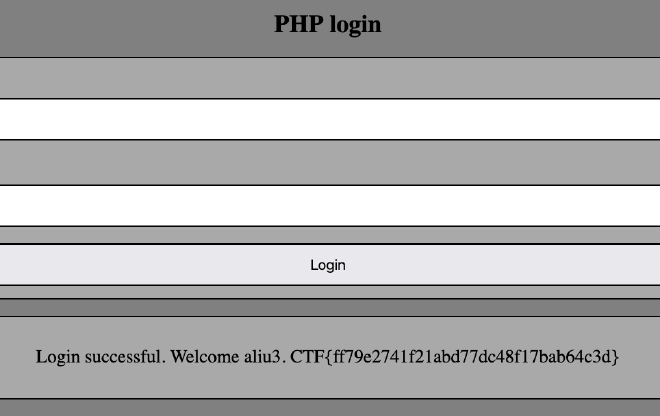Google CTF 2023 Writeup
Table of Contents
A CTF organized by Google. I only solved 1 web challenge but learnt a lot of things for other categories.
Google uploaded the complete solution writeups immediately after the challenge is over. This was great since I always wanted to read the author’s writeup or thoughts for the solution. Hopefully other CTF events can do the same.
web/under-construction #
- solved
- description: We were building a web app but the new CEO wants it remade in php.
- solves: 466
The challenge consists with 2 applications: flask and php apps. The page has a signup & login where the CEO can view the flag in the php app but users can only signup in the flask app. Each user can signup with different tier and only CEO can sign up with GOLD tier.
In the signup route in python, we can see the validation
def signup_post():
raw_request = request.get_data()
username = request.form.get('username')
password = request.form.get('password')
tier = models.Tier(request.form.get('tier'))
# ...
if(tier == models.Tier.GOLD):
flash('GOLD tier only allowed for the CEO')
return redirect(url_for('authorized.signup'))
# ...
requests.post(f"http://{PHP_HOST}:1337/account_migrator.php",
headers={"token": TOKEN, "content-type": request.headers.get("content-type")}, data=raw_request)
Once the user is validated and inserted to the database. It is also to the php app via the special API token to the endpoint. However, the migration request body is the raw data (data=raw_request) instead of the validated request. This is where we can bypass the validation.
In the php migrator endpoint, the request is only validated as a no empty string for tier.
if (!isset($_POST['username']) || !isset($_POST['password']) || !isset($_POST['tier'])) {
http_response_code(400);
exit();
}
if (!is_string($_POST['username']) || !is_string($_POST['password']) || !is_string($_POST['tier'])) {
http_response_code(400);
exit();
}
insertUser($_POST['username'], $_POST['password'], $_POST['tier']);
The php app does not validate. With how php and flask read the body, they can be reading different value. In flask, the first occurrence wins, in php, the last occurrence wins. So we can construct our request body to be like this to bypass the validation.
username=aliu&password=dev&tier=blue&tier=gold
And signin to the php app with the new user, then we can see the flag.

misc/papapapa #
- unsolved
- description: Is this image really just white?
- solves: 128
This is the challenge I spent my most of time on. The challenge is only a white jpg. There is nothing else and when opened, it is only a white image. I used strings and exiftool but they showed nothing. I tried looking at the hex code values, it looks like there are some values. I can see sections of 00 and some random values. This tells me something is hidden within the jpeg.
This is where I was stuck. I started looking into how could someone include a flag into the jpg image. There are a lot of steganography tools. Steganography is the practice of concealing information within another message or physical object to avoid detection.
I found 2 things binwalk and stegsolve
binwalk: Binwalk is a tool for searching a given binary image for embedded files and executable code. Installed by brew install binwalk.
stegsolve: Able to see different alpha channels and grayscale of the image.
Installed with this repository for Mac users
git clone https://github.com/tex2e/stegsolve-macos
javac stegsolve/*.java
jar cvfm stegsolve.jar META-INF/MANIFEST.MF -C stegsolve/*.class
# usage
java -jar stegsolve.jar
However, these 2 tools did not show any flag for me. The image seems like just only want to show the white part of the image.
LSB Steganography #
This is a technique of hiding message inside an image. LSB stands for Least Significant Bit. The idea is that if we change the last bit value of a pixel, there won’t be much visible change in the color. For example, 0 is black. Changing the value to 1 won’t make much of a difference since it is still black, just a lighter shade.
I wrote a python scrip to loop through the last bit of the image and try to convert them into message but failed. At this point, I stopped since I don’t think I could “discover” any more information from the image. But I did come up with a short steps of what to do next time if I see a image challenge again
Image related steps
- Check the header for binary format, maybe the header is corrupted
- Try
stringsfor hidden message - Try
exiftoolfor metadata - Try
binwalkfor extracting hidden file within the file - Try
https://www.tineye.com/to reverse image search - Try
stegsolveto see different alpha channels or other image operations
papapa solution #
See author's solution, it looks like a simple solve but pretty amazing challenge.
Conclusion #
This was a cool CTF since it was hosted by Google and the challenges were pretty interesting. For jpg challenge it was new to me so I was learning a lot just by searching the category. Hopefully next time I will be able to solve similar challenges.